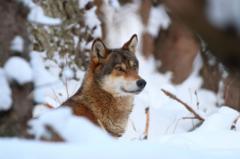In the picturesque Romanian village of Sansimion, nestled within the Carpathian mountains, shepherd József Rácz and his sons guard their flock of 500 ewes against the growing threat of predators. As the first snow blankets the region, Rácz reflects on the harsh realities of shepherding, a struggle compounded by the yearly loss of five to six ewes to wolves or bears. To defend against these predators, Rácz relies on the vigilant support of his 17 dogs, calling them invaluable companions in safeguarding the flock.
This week, a crucial decision looms over the future of wolves in Europe, as the European Commission debates shifting their status from Annex II (stringently protected) to Annex III (protected) of the Bern Convention. This change would enable individual EU countries to impose annual hunting quotas, a move that has sparked deep concern among conservationists. The Commission argues that wolf populations have surged dramatically from 11,000 in 2012 to more than 20,000 currently, attributing significant livestock damage to these predators.
However, wildlife advocates counter that enhanced protective measures, such as trained sheepdogs, could provide a more effective solution than culling. They assert that wolves play a crucial role in maintaining ecological balance by regulating populations of deer and wild boar, which can otherwise devastate forests and crops. Furthermore, wolves contribute to disease control by preying on sick animals, a concern highlighted by biologist Michal Haring from Slovakia, especially in light of the spreading African swine fever disease across Europe.
At a recent meeting of wildlife experts near Rácz’s village, many voiced opposition to the hunting of wolves and bear populations, presenting data that indicates the number of sheep killed by wolves is minimal relative to the overall livestock population in Europe. Despite concerns about attacks on sheep, only 0.065% of the continent’s sheep and goats are lost annually to wolves, and no human fatalities due to wolf attacks have occurred in the last 40 years.
Following this rationale, Laurent Schley, head of the Wildlife department in Luxembourg, emphasized the responsibility of wealthier nations to coexist with wolves, paralleling expectations placed on countries like India to protect tigers and Africa to conserve its elephants. Although Luxembourg has not yet encountered wolves, Schley acknowledges that suitable conditions for their return exist.
Despite the broader ecological picture, shepherd Rácz remains firm in his belief that wolves are a threat, citing their intelligence and pack-hunting tactics that can lead to devastating losses in his flock. His personal experiences with wolf predation, including the loss of his treasured dog, have only solidified his stance for tougher regulations to manage wolf populations.
Caught at the intersection of agricultural interests and wildlife conservation, the ongoing debate over wolf protections in Europe reflects the complexities of ensuring both the safety of livestock and the preservation of vital ecosystem roles, as stakeholders weigh the consequences of policy changes.



















